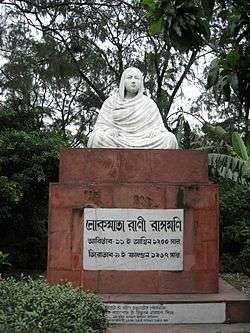Mahishya

Mahishya, also spelled Mahisya, is a Bengali Hindu agrarian caste. It is believed that the Mahishyas are basically 'Haliya' Kaibartas or 'Chashi' (ploughmen) Kaibartas, who abandoned traditional occupation like fishing and took up agriculture.[1][2] The Mahishyas do not enjoy any reservation benefits and are thus considered as a Forward caste group. They are traditionally found in the Indian states of West Bengal and Odisha. Mahishyas are one of the predominant castes in West Bengal, especially in the southern districts of Howrah, Paschim Medinipur, Purba Medinipur, Hooghly and South 24 Parganas. Some members are now employed in the business and service sectors as well.[3]
Mythology
According to ancient texts like Manusmriti, the term Mahishya refers to one born to a Kshatriya father and a Vaishya mother, supposed to be engaged in the profession of music, astronomy or agriculture.[4][5] Some sources mention Vira Sena (or Adisura), founder of the Sen family, as a Mahishya.
History
Although many are still involved in traditional work in rural areas, within a generation Mahishyas gave up agriculture in large numbers in favour of engineering and skilled labour in the urbanised areas of Howrah and Kolkata. In Howrah, the Mahishyas are the most numerous and successful businesspeople. At the turn of the 20th century, much of the land and factories were owned by Kayasthas; but by 1967, the Mahisya community owned 67 percent of the engineering businesses in the district.[6]
Social stigma
Although the financial, social, and political success of Mahishyas is notable, they have often been stigmatised due to their agrarian roots. Mahishyas have not been averse to manual labour (often considered demeaning by higher castes);[6] for example, Birendranath Sasmal was refused the post of Chief Executive of the Calcutta Municipal Corporation by Chittaranjan Das on the grounds that his appointment would offend the Kayasthas of the city.[7] The job ultimately went to Subhas Chandra Bose.
Notables
- Rani Rashmoni (1793 — 1861)
See also
References
- ↑ Openshaw, Jeanne (2002). Seeking Bauls of Bengal. Cambridge University Press. p. 95. ISBN 978-0-52181-125-5.
- ↑ Sharma, Jayeeta (2011). Empire’s Garden: Assam and the Making of India. Duke University Press. p. 215. ISBN 978-0-82235-049-1.
- ↑ Raychaudhuri, Arun, et al.; (2003). "Heritability Estimates of Height and Weight in Mahishya Caste Population." (– Scholar search). Int. J. Hum. Genet. 3 (3): 151–154.
- ↑ Agarwalla, Shyam. S. (1998). Religion and Caste Politics. Rawat Publications. p. 133.
- ↑ Kumar, Sangeet (2005). Changing Role of the Caste System: A Critique. Jaipur, India: Rawat Publications. p. 48. ISBN 8170338816.
- 1 2 Lessinger, Johanna M. (1982). "The New Vaishyas.". Economic Development and Cultural Change. 30 (4): 920–924. doi:10.1086/452603.
- ↑ Maity, Sachindra (1975). Freedom Movement in Midnapore. Calcutta: Firma, K.L.